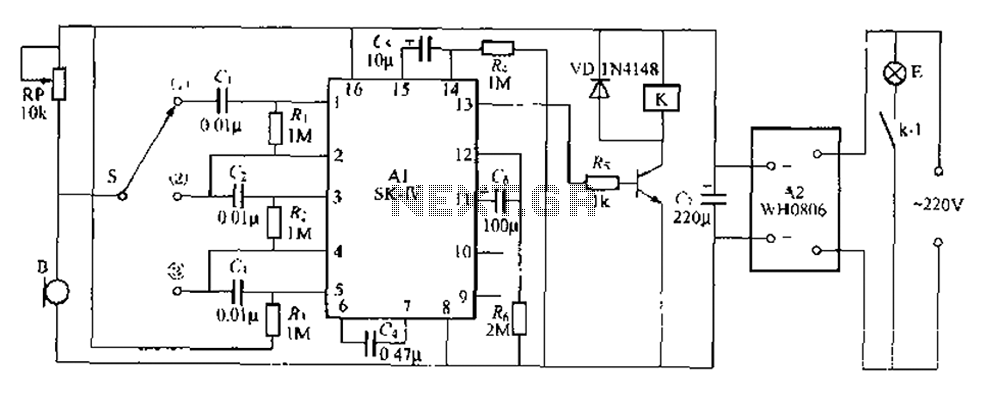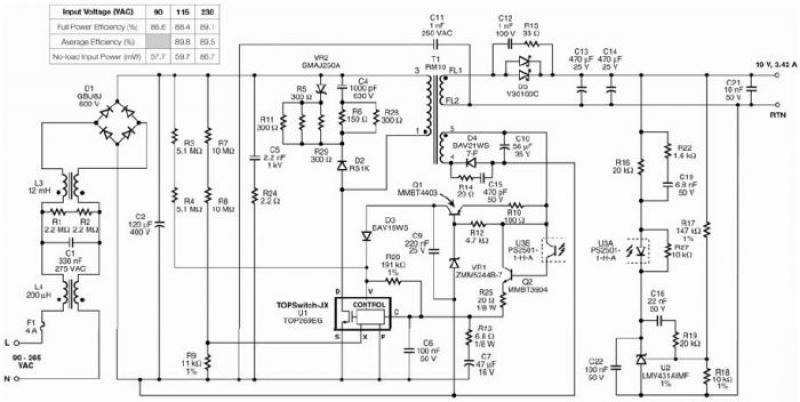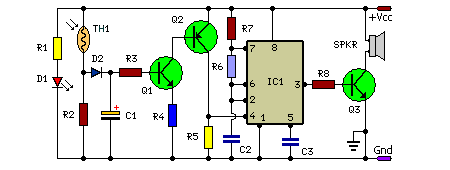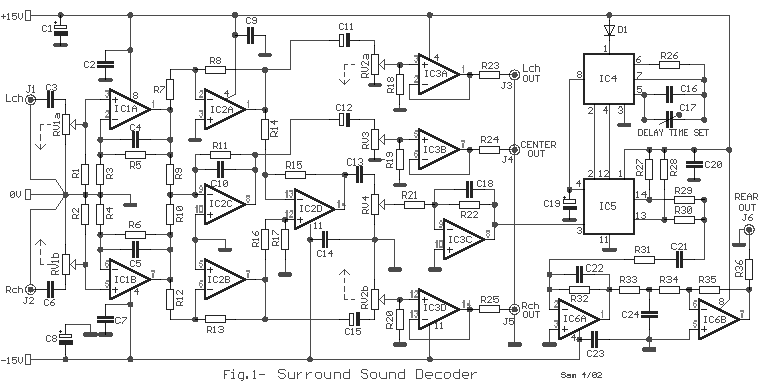
Voice-activated light switch delay circuit 1

This circuit is a robust light control delay switch with strong anti-interference capabilities. It requires a specific sequence of claps to activate the lamp, which will illuminate for a predetermined duration before automatically turning off. The circuit design is fundamentally similar to previous examples, with modifications to the transistor's base resistance. The integrated circuit connections have been adjusted, and resistive and capacitive delay elements have been incorporated to modify the delay characteristics. The circuit allows for adjustable delay times based on the values of the resistors and capacitors used, enabling the user to customize the duration for which the lamp remains lit according to individual preferences.
The described light control delay switch circuit employs a clap-activated mechanism to control the illumination of a lamp. The design incorporates a microphone or sound sensor that detects the sound of clapping. Upon receiving a specific number of claps within a designated timeframe, the circuit triggers a transistor that completes the circuit for the lamp, allowing it to light up.
The transistor (VT) serves as the primary switching element, while the base resistance (R) is crucial for controlling the transistor's activation threshold. The integrated circuit (IC) plays a vital role in processing the input signal from the sound sensor, ensuring that only the intended clap signals are recognized and processed. The modifications to the circuit include the adjustment of the resistor values and the integration of a capacitive delay element (C) that collectively determine the timing characteristics of the lamp's illumination.
The adjustable delay feature is achieved by allowing the user to change the values of resistors (R) and capacitors (C) in the circuit. By altering these components, the delay time for the lamp can be extended or shortened, providing flexibility based on user requirements. This adaptability ensures that the lamp remains lit for a user-defined duration after activation, enhancing user experience and functionality.
In summary, this light control delay switch circuit is designed for effective clap detection and lamp control, with robust anti-interference capabilities and customizable delay settings. The circuit's efficiency and versatility make it suitable for various applications where hands-free operation and adjustable timing are desired.A strong anti-interference ability Lu light control delay switch circuit, it needs within a specific time in a row clapping I. lamp lit square Xi, after a delay, lights automat ically turn off. Ji Guan on this circuit example is basically the same, except that the transistor VT base resistance R. Original left foot then Sk t integrated circuits ? ? change received the first leg, and then affixed in ?tJ. ? feet respectively resistive and capacitive delay element R. And G, put the original voice of the city open to change Yan Ge opening delay. Changes in R;, c. Numerical length adjustable circuit of a specific time; change R, value then adjust the delay time of the circuit-cho, namely E lamp lighting the length of time the reader according to their own needs to be adjusted.
The described light control delay switch circuit employs a clap-activated mechanism to control the illumination of a lamp. The design incorporates a microphone or sound sensor that detects the sound of clapping. Upon receiving a specific number of claps within a designated timeframe, the circuit triggers a transistor that completes the circuit for the lamp, allowing it to light up.
The transistor (VT) serves as the primary switching element, while the base resistance (R) is crucial for controlling the transistor's activation threshold. The integrated circuit (IC) plays a vital role in processing the input signal from the sound sensor, ensuring that only the intended clap signals are recognized and processed. The modifications to the circuit include the adjustment of the resistor values and the integration of a capacitive delay element (C) that collectively determine the timing characteristics of the lamp's illumination.
The adjustable delay feature is achieved by allowing the user to change the values of resistors (R) and capacitors (C) in the circuit. By altering these components, the delay time for the lamp can be extended or shortened, providing flexibility based on user requirements. This adaptability ensures that the lamp remains lit for a user-defined duration after activation, enhancing user experience and functionality.
In summary, this light control delay switch circuit is designed for effective clap detection and lamp control, with robust anti-interference capabilities and customizable delay settings. The circuit's efficiency and versatility make it suitable for various applications where hands-free operation and adjustable timing are desired.A strong anti-interference ability Lu light control delay switch circuit, it needs within a specific time in a row clapping I. lamp lit square Xi, after a delay, lights automat ically turn off. Ji Guan on this circuit example is basically the same, except that the transistor VT base resistance R. Original left foot then Sk t integrated circuits ? ? change received the first leg, and then affixed in ?tJ. ? feet respectively resistive and capacitive delay element R. And G, put the original voice of the city open to change Yan Ge opening delay. Changes in R;, c. Numerical length adjustable circuit of a specific time; change R, value then adjust the delay time of the circuit-cho, namely E lamp lighting the length of time the reader according to their own needs to be adjusted.





